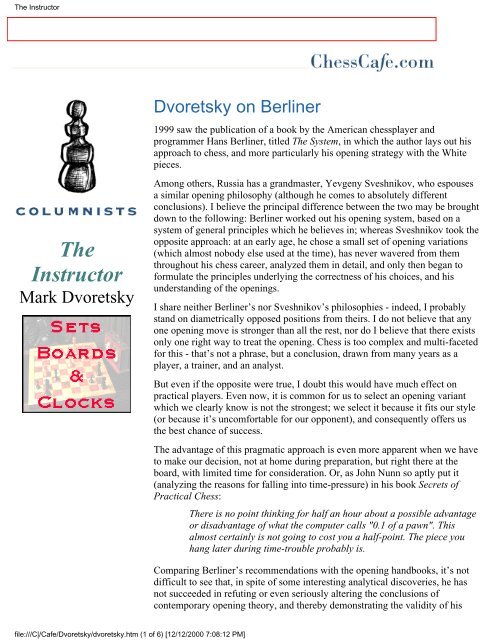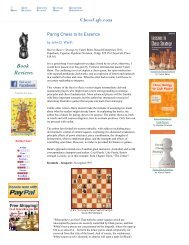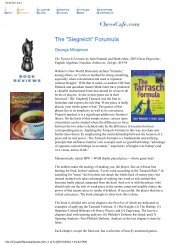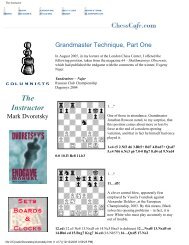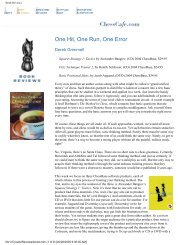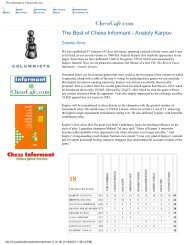Dvoretsky on Berliner - Chess Cafe
Dvoretsky on Berliner - Chess Cafe
Dvoretsky on Berliner - Chess Cafe
Create successful ePaper yourself
Turn your PDF publications into a flip-book with our unique Google optimized e-Paper software.
The Instructor<br />
The<br />
Instructor<br />
Mark <str<strong>on</strong>g>Dvoretsky</str<strong>on</strong>g><br />
<str<strong>on</strong>g>Dvoretsky</str<strong>on</strong>g> <strong>on</strong> <strong>Berliner</strong><br />
1999 saw the publicati<strong>on</strong> of a book by the American chessplayer and<br />
programmer Hans <strong>Berliner</strong>, titled The System, in which the author lays out his<br />
approach to chess, and more particularly his opening strategy with the White<br />
pieces.<br />
Am<strong>on</strong>g others, Russia has a grandmaster, Yevgeny Sveshnikov, who espouses<br />
a similar opening philosophy (although he comes to absolutely different<br />
c<strong>on</strong>clusi<strong>on</strong>s). I believe the principal difference between the two may be brought<br />
down to the following: <strong>Berliner</strong> worked out his opening system, based <strong>on</strong> a<br />
system of general principles which he believes in; whereas Sveshnikov took the<br />
opposite approach: at an early age, he chose a small set of opening variati<strong>on</strong>s<br />
(which almost nobody else used at the time), has never wavered from them<br />
throughout his chess career, analyzed them in detail, and <strong>on</strong>ly then began to<br />
formulate the principles underlying the correctness of his choices, and his<br />
understanding of the openings.<br />
I share neither <strong>Berliner</strong>’s nor Sveshnikov’s philosophies - indeed, I probably<br />
stand <strong>on</strong> diametrically opposed positi<strong>on</strong>s from theirs. I do not believe that any<br />
<strong>on</strong>e opening move is str<strong>on</strong>ger than all the rest, nor do I believe that there exists<br />
<strong>on</strong>ly <strong>on</strong>e right way to treat the opening. <strong>Chess</strong> is too complex and multi-faceted<br />
for this - that’s not a phrase, but a c<strong>on</strong>clusi<strong>on</strong>, drawn from many years as a<br />
player, a trainer, and an analyst.<br />
But even if the opposite were true, I doubt this would have much effect <strong>on</strong><br />
practical players. Even now, it is comm<strong>on</strong> for us to select an opening variant<br />
which we clearly know is not the str<strong>on</strong>gest; we select it because it fits our style<br />
(or because it’s uncomfortable for our opp<strong>on</strong>ent), and c<strong>on</strong>sequently offers us<br />
the best chance of success.<br />
The advantage of this pragmatic approach is even more apparent when we have<br />
to make our decisi<strong>on</strong>, not at home during preparati<strong>on</strong>, but right there at the<br />
board, with limited time for c<strong>on</strong>siderati<strong>on</strong>. Or, as John Nunn so aptly put it<br />
(analyzing the reas<strong>on</strong>s for falling into time-pressure) in his book Secrets of<br />
Practical <strong>Chess</strong>:<br />
There is no point thinking for half an hour about a possible advantage<br />
or disadvantage of what the computer calls "0.1 of a pawn". This<br />
almost certainly is not going to cost you a half-point. The piece you<br />
hang later during time-trouble probably is.<br />
Comparing <strong>Berliner</strong>’s recommendati<strong>on</strong>s with the opening handbooks, it’s not<br />
difficult to see that, in spite of some interesting analytical discoveries, he has<br />
not succeeded in refuting or even seriously altering the c<strong>on</strong>clusi<strong>on</strong>s of<br />
c<strong>on</strong>temporary opening theory, and thereby dem<strong>on</strong>strating the validity of his<br />
file:///C|/<strong>Cafe</strong>/<str<strong>on</strong>g>Dvoretsky</str<strong>on</strong>g>/dvoretsky.htm (1 of 6) [12/12/2000 7:08:12 PM]
The Instructor<br />
views.<br />
At the same time, <strong>Berliner</strong>’s c<strong>on</strong>crete analyses are meaty indeed (he is an<br />
outstanding analyst; it’s no accident that he w<strong>on</strong> the V World Corresp<strong>on</strong>dence<br />
Champi<strong>on</strong>ship by an overwhelming score). And his strategic c<strong>on</strong>cepti<strong>on</strong>s are<br />
indubitably based <strong>on</strong> rock-solid foundati<strong>on</strong>s - practical players would do well to<br />
study them. Just d<strong>on</strong>’t "absolutize" them: look at them as possible, and <strong>on</strong>ly<br />
sometimes the str<strong>on</strong>gest, ways of treating the positi<strong>on</strong>.<br />
<strong>Berliner</strong> successfully employed <strong>on</strong>e of his strategic c<strong>on</strong>cepti<strong>on</strong>s in the<br />
following game.<br />
<strong>Berliner</strong> - Ratner 1969 Eastern Open<br />
1. d4 Nf6 2. c4 c5 3. d5 e6 4. Nc3 ed 5. cd d6 6. e4 g6 7. Bd3 Bg7 8. Nge2<br />
Typical for <strong>Berliner</strong>, he does not develop the knight <strong>on</strong> f3, in order to leave the<br />
way clear for the f-pawn’s advance.<br />
8...0-0 9. 0-0 Na6 (9...a6 10. a4 Nbd7) 10. f3!?<br />
The usual theoretical c<strong>on</strong>tinuati<strong>on</strong> is 10. h3 Nc7 11. Ng3<br />
10...Nc7?! (10...Bd7; 10...Rb8) 11. Be3 Rb8 (See Diagram)<br />
12. Rab1!<br />
This is the star move of this game. During the 1960s I had been<br />
analyzing many of the System formati<strong>on</strong>s arising in various defenses<br />
to 1. d4...The c<strong>on</strong>clusi<strong>on</strong> that I came to is that in many of these<br />
openings, when Black has created no direct object for attack, White<br />
should make a space-grab <strong>on</strong> the queenside with the move b4. This<br />
frequently has to be prepared, almost always by Rb1, and never by a3<br />
unless Black prevents b4 with ...a5. So this is a rook move with a<br />
purpose. Openings such as the Dutch Defense, Old Indian and King’s<br />
Indian fall into this category.<br />
White plays b2-b4 in the hopes of eliminating the black pawn at c5, and thereby<br />
gaining access to the vital square d4.<br />
12...b5 13. b4! cb 14. Rxb4 a5 15. Rb1 Bd7 16. Nd4<br />
White’s goal is achieved; he now holds a positi<strong>on</strong>al advantage.<br />
16...Qe8 17. Qd2 b4?<br />
file:///C|/<strong>Cafe</strong>/<str<strong>on</strong>g>Dvoretsky</str<strong>on</strong>g>/dvoretsky.htm (2 of 6) [12/12/2000 7:08:12 PM]
The Instructor<br />
An unfortunate plan: exchanging pieces <strong>on</strong> b5. After the d7-bishop disappears,<br />
the square c6 becomes hopelessly weak.<br />
18. Nce2 Nb5 19. Nxb5 Bxb5 20. Bxb5 Qxb5 21. Nd4 Qa4 22. Nc6 Rb7 23.<br />
Bd4 Rd7?<br />
This costs a pawn, but Black’s game is difficult after 23...Ra8 24. Rfc1 also.<br />
24. Bb6! Ra8 25. Bxa5! Nxe4<br />
25...Rxa5 26. Rxb4 Qxa2 27. Rb8+ Bf8 28. Qh6+-.<br />
26. fe Bc3 27. Rxb4! Bxb4 28. Bxb4 Qxa2 29. Qd4 Ra4 30. Qf6 Rxb4 31.<br />
Nxb4<br />
Black’s a piece down, and could have resigned with a clear c<strong>on</strong>science.<br />
31...Qc4 32. Ra1! Qc8 33. Nc6 Qb7 34. h4 h5 35. Kh2 Kh7 36. Ra7 Qc8 37.<br />
Ne7, and Black resigned. 1-0<br />
The plan discovered by <strong>Berliner</strong> later became standard play in such positi<strong>on</strong>s.<br />
Here are a couple of examples.<br />
G. Giorgadze - L. Yurtaev Simferopol 1988<br />
1. d4 Nf6 2. c4 g6 3. Nc3 Bg7 4. e4 d6 5. Nge2 0-0 6. Ng3 c5 7. d5 e6 8. Be2<br />
ed 9. cd Na6 10. 0-0 Nc7 11. a4 a6 (See Diagram)<br />
12. Rb1! Nd7 (Black stops b2-b4<br />
temporarily) 13. Bf4 Ne5 14. Qd2 h5 15.<br />
Bg5 f6 16. Bh6 h4 17. Nh1 Bd7 18. Bxg7<br />
Kxg7 19. f4 Nf7 20. Nf2 b5 21. ab ab 22.<br />
b4 c4 23. Qd4 Qe7 24. Bg4 Bxg4<br />
(24..Ra3!?) 25. Nxg4 Ra3 26. Rf3 Nh6?!<br />
(26...Rh8) 27. Nxh6 Kxh6 28. Qf2 f5 29.<br />
e5 de 30. fe Qxe5 31. Qxh4+ (31 Re1!?<br />
intending 32 Ne4) 31...Kg7 32. Re1 Qf6<br />
33. Qxf6+ Rxf6 34. d6 Rxd6 35. Re7+<br />
Kg8 36. Rxc7 Rd2 37. h4, and Black<br />
resigned 1-0<br />
1. d4 Nf6 2. c4 e6 3. g3 c5 4. d5 ed 5. cd b5 6. Bg2 d6 (See Diagram)<br />
In this positi<strong>on</strong>, White usually c<strong>on</strong>tinued 7.<br />
Nf3 or 7. e4. But in the early 80’s, White<br />
found the dangerous pawn sacrifice 7.<br />
b4!?, with the same strategic point as in<br />
the <strong>Berliner</strong> game: the occupati<strong>on</strong> of d4.<br />
7...cb is met by 8. a3 ba (8...b3 9. Qxb3 a6<br />
10. a4 ba 11. Qxa4+ Nbd7 12. Nf3 Be7 13.<br />
Nd4 0-0 14. Nc6 Qe8 15. Be3+/-. Alburt -<br />
I. Ivanov, New York 1983) 9. Nxa3, with<br />
good compensati<strong>on</strong>. For instance: 9...Qd7<br />
(9...Bd7!? Zaichik - Vladimirov, 1981) 10.<br />
Qb3 Na6 11. Qxb5 Rb8 12. Qxd7+ Bxd7<br />
file:///C|/<strong>Cafe</strong>/<str<strong>on</strong>g>Dvoretsky</str<strong>on</strong>g>/dvoretsky.htm (3 of 6) [12/12/2000 7:08:12 PM]
The Instructor<br />
13. Nc2! Nc5 14. Rxa7 Be7 15. Nf3 Nxd5 16. Nfd4 Nc3 17. Nc6 Rc8 18.<br />
Nxe7 Kxe7 19. Nd4+/- (Sos<strong>on</strong>ko - Adorjan, Wijk aan Zee 1984).<br />
Or 7...Na6 8. bc Nxc5 9. Nf3 g6 10. 0-0 (10 Nd4!?) 10...Bg7 11. Nd4 0-0?!<br />
(11...Bb7) 12. Nc3! a6 (12...b4 13. Nc6 Qd7 [13..Qb6 14. Rb1] 14. Nb5!, with<br />
advantage to White) 13. Nc6 Qc7 14. Be3 Bb7 15. Bd4 Rfe8 16. a4!+/-<br />
(Kasparov - Korchnoi, 11th match game, L<strong>on</strong>d<strong>on</strong> 1983).<br />
The following attempt to employ the same approach is somewhat less trivial:<br />
<strong>Berliner</strong> proposes a whole new way of playing a popular opening system.<br />
1. d4 Nf6 2. c4 g6 3. Nc3 Bg7 4. e4 d6 5. f3 0-0 6. Be3 Nc6 (See Diagram)<br />
Theory examines <strong>on</strong>ly 7. Nge2 or 7. Qd2.<br />
<strong>Berliner</strong> thinks the str<strong>on</strong>gest move is <strong>on</strong>e<br />
that isn’t even menti<strong>on</strong>ed in the opening<br />
books!<br />
7. Rb1 (!! - <strong>Berliner</strong>)<br />
The move b2-b4 is imminent and will sweep aside all of Black’s hopes<br />
<strong>on</strong> the queenside <strong>on</strong>ce it is played. White need <strong>on</strong>ly be careful about<br />
his timing, as there may be tactical counterchances starting with ...e5<br />
and if d5, then ...Nd4. So we have.<br />
a) On 7...Bd7 (7...a6 leads to similar play) White plays 8. b4. Now, in<br />
order to avoid being swept away, Black is practically forced to play<br />
8...e5 9. d5 Nd4 10. Nge2 Nh5! 11. Qd2! (11. Nxd4 ed 12. Bxd4 Qh4+<br />
is too str<strong>on</strong>g; however, now Bf2 becomes possible as the c3-knight is<br />
defended.) Now Black can no l<strong>on</strong>ger maintain the d4-knight without<br />
sacrificing a pawn in a rather unproductive way. If 11...Qf6, then 12.<br />
Bg5. Or if 11...Qh4+ 12. Bf2 Qf6 13. Nxd4 ed 14. Ne2. And 11...c5 12.<br />
dc is hardly to be c<strong>on</strong>sidered. So Black must play 11...Nxe2 12. Bxe2,<br />
when White has an excellent positi<strong>on</strong>, several tempi ahead of similar<br />
positi<strong>on</strong>s that occur in this variati<strong>on</strong>. 12...f5 can be met by 13. 0-0,<br />
when 13...Nf4 14 Bd1 Qg5?! 15. Kh1 Qh5 16. Bc2 gives White a<br />
formidable queenside initiative, while Black’s attack still has a l<strong>on</strong>g<br />
way to go before it becomes dangerous. Nor does 13...f4 14. Bf2 Bf6<br />
15. Qe1 g5 16. c5 offer Black much as White is again well ahead<br />
compared to usual positi<strong>on</strong>s in this variati<strong>on</strong>.<br />
b) Nor does 7...a5 8. a3! change anything. White will still advance b4,<br />
and not worry about the a-file, which will bel<strong>on</strong>g to White in the<br />
not-too-distant future.<br />
c) On the immediate 7...e5 8. d5 Nd4 (8...Ne7 9 b4 and the queenside<br />
file:///C|/<strong>Cafe</strong>/<str<strong>on</strong>g>Dvoretsky</str<strong>on</strong>g>/dvoretsky.htm (4 of 6) [12/12/2000 7:08:12 PM]
The Instructor<br />
attack is underway) 9. Nge2 c5 (if 9...Nxe2 10. Bxe2, and White is<br />
several tempi ahead of the standard variati<strong>on</strong>s in which White attacks<br />
<strong>on</strong> the queenside and Black <strong>on</strong> the kingside) 10. dc Nxc6 and White<br />
has a large positi<strong>on</strong>al advantage.<br />
Let’s take a critical look at <strong>Berliner</strong>’s analysis. What is the drawback of his<br />
proposed move, 7. Rb1? First of all, the fact that instead of developing his<br />
kingside pieces, White begins a rather abstract assault <strong>on</strong> the other side; he thus<br />
risks falling behind in development.<br />
For example, we could try 7...a5 8. a3 Bd7. <strong>Berliner</strong> thinks that, after playing<br />
b2-b4, White will so<strong>on</strong> wrest the a-file away from his opp<strong>on</strong>ent (obviously, as a<br />
result of his prep<strong>on</strong>derance <strong>on</strong> the queenside). And so it would be, if White had<br />
the time. But this will not happen if Black succeeds in opening the center<br />
quickly.<br />
9. b4 ab 10. ab e5 11. d5 Nd4 12. Nge2 Nh5 13. Qd2 (all so far as analyzed by<br />
<strong>Berliner</strong>, except with the inclusi<strong>on</strong> of the a-pawn moves) 13...f5! 14. Nxd4 ed<br />
15. Bxd4 Bxd4 16. Qxd4 Qh4+ 17. Qf2 Qf6. Black obviously has more than<br />
enough for a pawn, and the opening of the a-file was clearly good for him.<br />
White should probably not follow his intended plan in this instance. 7...a5 is<br />
better met by the usual plan of 8. Nge2 or 8. Qd2. It’s not so easy to determine,<br />
in that case, who is favored by the inclusi<strong>on</strong> of the moves 7. Rab1 a5; most<br />
probably White. Yes, he has lost the right to castle queenside, which he<br />
sometimes does in this system; <strong>on</strong> the other hand, Black no l<strong>on</strong>ger has his<br />
standard plan of ...Rb8, ...a7-a6 and ...b7-b5.<br />
But Black is within his rights to try this pawn sacrifice even without the<br />
preliminary opening of the a-file.<br />
7...Bd7 8. b4 e5 9. d5 Nd4 10. Nge2 Nh5 11. Qd2 f5!?<br />
11...a5!? deserves close scrutiny as well. We already know the c<strong>on</strong>sequences of<br />
12. a3 ab 13. ab f5! On 12. b5, the queenside assault is stopped in its tracks,<br />
while winning a pawn by 12. ba or 12. Nxd4 ed 13. Bxd4 looks too risky.<br />
12. Nxd4 ed 13. Bxd4 Bxd4 14. Qxd4 Qh4+ 15. Qf2<br />
15. Kd1 is met by 15...Ng3 (15...fe 16. Nxe4 Bf5 isn’t bad, either) 16. Qf2 Qf6<br />
17. hg Qxc3, threatening not <strong>on</strong>ly 18...fe, but also 18...Ba4+.<br />
15...Qf6, and Black has compensati<strong>on</strong>.<br />
With White’s king stranded in the center, and his dark squares weak, Black<br />
obviously has fully sufficient counterplay.<br />
Translated by Jim Marfia<br />
Copyright 2000 Mark <str<strong>on</strong>g>Dvoretsky</str<strong>on</strong>g>. All rights reserved.<br />
file:///C|/<strong>Cafe</strong>/<str<strong>on</strong>g>Dvoretsky</str<strong>on</strong>g>/dvoretsky.htm (5 of 6) [12/12/2000 7:08:12 PM]
The Instructor<br />
[The <strong>Chess</strong> <strong>Cafe</strong> Home Page] [Book Reviews] [Bulletin Board] [Columnists]<br />
[Endgame Studies] [The Ninth File] [The Skittles Room] [Archives]<br />
[Links] [Online Bookstore] [About The <strong>Chess</strong> <strong>Cafe</strong>] [C<strong>on</strong>tact Us]<br />
Copyright 2000 Cyber<strong>Cafe</strong>s, LLC. All Rights Reserved.<br />
"The <strong>Chess</strong> <strong>Cafe</strong>®" is a registered trademark of Russell Enterprises, Inc.<br />
file:///C|/<strong>Cafe</strong>/<str<strong>on</strong>g>Dvoretsky</str<strong>on</strong>g>/dvoretsky.htm (6 of 6) [12/12/2000 7:08:12 PM]


